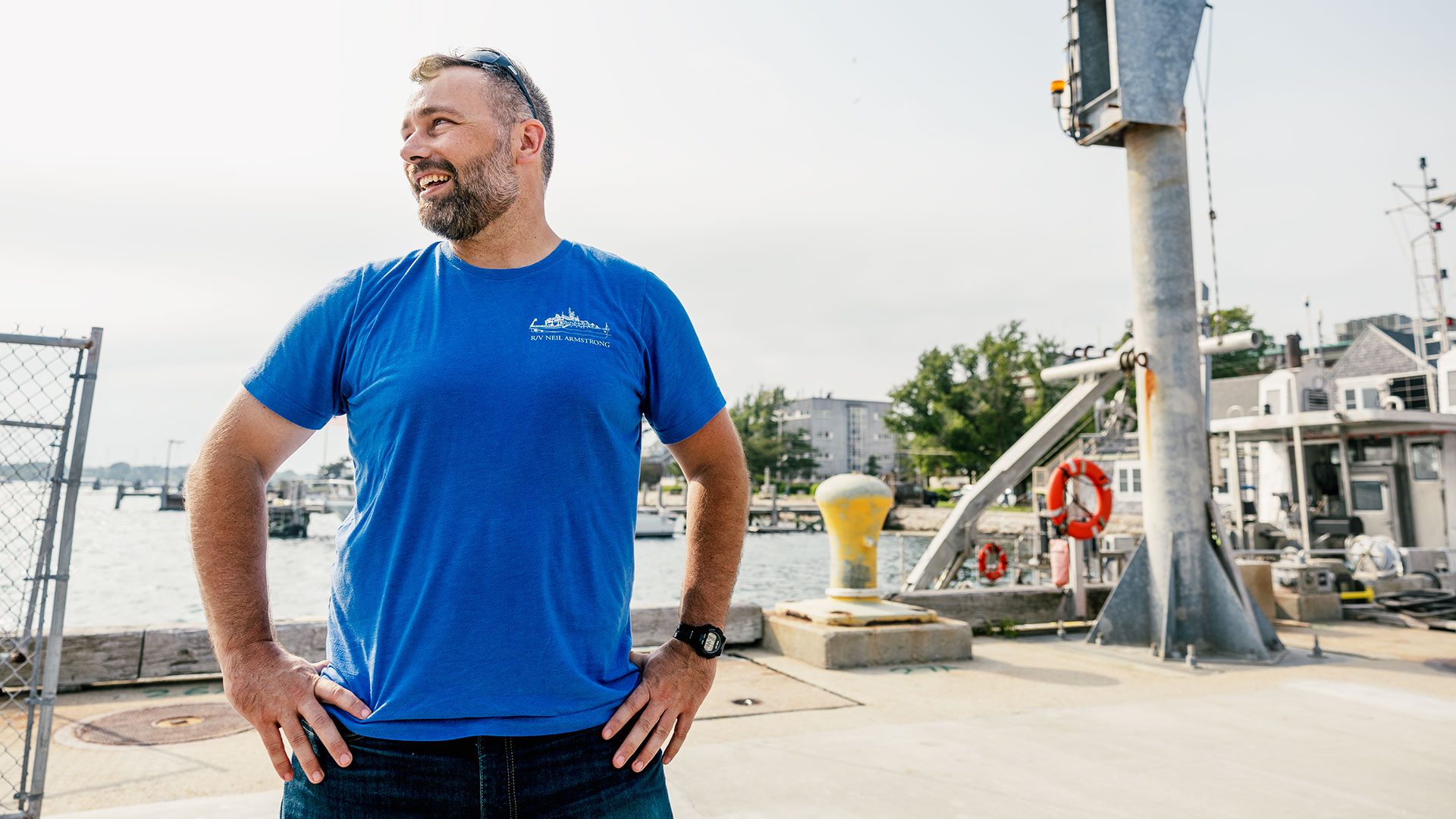
Measuring the great migration
A bioacoustic mooring will use sound to help estimate life migrating in the ocean’s twilight zone as part of a new long-term observation network in the Atlantic
Estimated reading time: 6 minutes
A rainbow of colors swept in from the right side of the computer screen.
Aboard the research vessel Neil Armstrong, Andone Lavery, a WHOI acoustical oceanographer, and MIT-WHOI PhD student Zhaozhong Zhuang, were downloading the first echogram from a new bioacoustic echo-sounder that had spent four days at roughly 1,900 feet (580 meters)-in the heart of the ocean's twilight zone. The colors, bold stripes of red and yellow tapering into greens and blues, represent the sound that echoes off animals in the mid-ocean depths. As the data played back across the screen, showing the passage of time, these colorful bands began to inch up toward shallower waters.
"This is fantastic," says Lavery. "Not only can you see the daily vertical migration, but at close ranges you can also see individual [fish]."
Acoustics are a powerful tool for exploring the vast, remote, and relatively unexplored twilight zone. Scientists like Lavery want to use it to investigate the many deep-sea creatures that make a nightly exodus to the surface. Those that do may be helping the planet by eating and moving CO2 to deeper depths, keeping that greenhouse gas from entering the atmosphere. But what researchers don't know is how important all this movement truly is and if it changes over time.
That's about to change, thanks to a new Ocean Twilight Zone Observation Network. In July, Lavery and Zhuang joined a dozen WHOI scientists and engineers to deploy three of five scientific moorings that will use sound to provide different insights into an area of the Atlantic Ocean nearly six times the size of New England.
The rainbow of acoustic data Lavery and Zhuang downloaded came from one of three moorings deployed by the team, a boulder-sized sphere, outfitted with a small echo-sounder that sends out short, dolphin-like whistles into the twilight zone. For five minutes, every half hour, during the next four months, this bioacoustic instrument will help measure and track life traveling to and from the surface waters, creating a detailed picture of their migration over time.
"All of our experiments so far have been short-duration, process-based cruises that have been over one-week or two-week durations," explains Lavery. "This bioacoustic mooring will help us look at a long time-series of daily vertical migrations."
Deciding which frequency the bioacoustic mooring would use to create this map, however, was a far more complex task.
Four days after deploying the bioacoustic mooring out to sea, it was recovered, so Lavery and her team could assess the data taken up by the echo-sounder. The visualization of that sound reflected or "scattered" by fish, is known as an echogram. (Video by Daniel Hentz, © Woods Hole Oceanographic Institution)
Getting in tune
Nearly everything in the ocean has a sound signature. Lavery calls this, "acoustic DNA."
Underwater, sounds can harmlessly echo from animals, scattering soundwaves back to nearby sources, like the echo-sounder mentioned earlier. Some organism, like fish, have a stronger echo at some frequencies. "Tuned" correctly, echo-sounders can get a clear picture of these types of organisms. The result is a coherent map of where some animals are in the water column, like the echogram Lavery and Zhuang saw.
Denizens of the twilight zone are easier to see on this map using different sound frequencies, making it hard for scientists to choose the right note to play from echo-sounders. But for seasoned marine biologists who regularly use acoustics to count fish stocks, there are a helpful guidelines when deciding on what sound to use, where to use it in the water, and for how long.
"There are a lot of trade-offs in picking the right technology. You can't be pinging 24/7, 365 days a year," says NOAA Fisheries Biologist Mike Jech about acoustic technologies. "But we've never had any issues using a frequency we needed."
Jech previously collaborated with Lavery on a towable acoustic vehicle called Deep-See to use acoustics inside the twilight zone, where ship-borne echo-sounders couldn't reach. He's since spent years learning how to abide by the sound etiquette of the sea. For him, this means weighing the pros and cons of each pitch before anything even goes in the water.
By using higher-pitched frequencies, for instance, scientists can start to see tiny crustaceans like copepods. But these shorter soundwaves can't reliably penetrate the full depth range of the twilight zone without getting lost in the static of other ocean noises. Deep-See and the echo-sounder use sound at-depth, making it easier to avoid this problem.
On the lower end of the acoustic scale, sounds travel farther and deeper, often granting scientists clearer signals when looking at larger creatures. But there's another catch.
"One of the biggest limitations in using acoustics is with marine mammal interactions," says Jech. "For example, it's harder to use lower frequencies that are in the same communication band as some species of large whales." That would be as difficult as trying to talk at the same vocal pitch and time as someone else.
Thankfully, WHOI’s bioacoustics mooring has been designed to minimize the impact on whales by choosing a set of pitches that impacts fewer animals. The sound beam leaving the mooring is also upward facing and slim—something Lavery says will keep sound from spreading far across the ocean.
The mooring's chosen frequency (inaudible to humans, at 38 kHz), came down to getting the most bang for its auditory buck with the smallest acoustic footprint. That meant "tuning" the instrument to the most prolific commuters in the twilight zone, namely fish that have swimbladders, like lanternfish. While Lavery and her colleagues won't be able to see everything, they'll be able to track a sizable majority of life migrating from the mid-ocean.
The syntactic foam sphere of the bioacoustic mooring is strung out from the aft deck of R/V Neil Armstrong on its first test deployment in July. (Video by Daniel Hentz, © Woods Hole Oceanographic Institution)
A race against time
For the bioacoustic mooring to produce an informative picture of how the great migration looks over time, Lavery says it must work in concert with all the other research initiatives taking place in the ocean twilight zone. Scheduled cruises, net tows to collect fish and other twilight zone creatures, and chemical samples from autonomous vehicles like Mesobot will continue to be regular parts of the research regimen.
"Think of acoustic information as an Impressionist painting-it doesn't give you the details, no matter how close up you look," says Lavery. "You should never use acoustics by themselves."
In time, the mooring will give twilight zone investigators a greater sense for how much atmospheric carbon is stored in deeper water by these critters, a cycle known as the ocean's biological carbon pump. It may also tell them how sensitive twilight zone creatures are to environmental changes like ocean warming.
As the world eyes the mid-ocean for potential fisheries, it'll become more important to understand how much exploitation (if any) the twilight zone can sustain. Marine policy experts say information from technology in the observation network could help answer that question.
"If taking a globally holistic approach to how we feed people means fishing the mesopelagic, then it has the potential to alleviate a lot of global problems," says Aria Ritz-Finkelstein, an MIT-WHOI PhD student and liaison at WHOI's Marine Policy Center. "But to figure out how to manage those things, we need to understand the quantities that we're dealing with. How much protein are we talking about? And how can we fish this region without depleting it to a point that it's unsustainable?"
Next year, the United Nations General Assembly will convene its fourth and final session on international laws governing the use of resources on the high seas. By then, the bioacoustic mooring and the Ocean Twilight Zone Observation Network may already be offering insights into how fragile or robust this marine ecosystem truly is.
"I want to help people make good choices, if that's possible," says Lavery. "It's exciting to be possibly a part of a sustainable solution."



